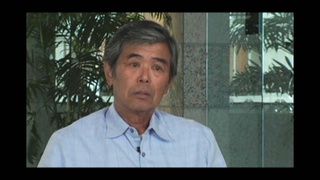Interviews
You can't change the weather
In Japan, it’s a little colder than Los Angeles. So, you have to kind of adjust that part, too. And then Japan is more, well, they have more humidity and Los Angeles is a little more drier. So, you have to kind of think about that and try to keep bonsai so that they’ll sort of get along with drier humidity. So that means, well, you can’t change that weather condition, but you change the material. So, maybe in Japan a certain kind of a pine tree get along good with their humidity. So, we have our pine tree get along with our humidity. So, that’s how, you know, you change the material. You can’t change the weather, you know. So, you change the material so the material will go along with original [climate].
[reading]
Yeah, well, the soil and water is different, too. Because the material’s different, I have to use soil and water according to this material that I used over here. So naturally, we have that soil and water over here. So, I don’t pay attention Japanese soil or water. It’s just the material we all live in, you know. So, I use this native soil and water. Then material will survive.
Date: February 4, 2004
Location: California, US
Interviewer: Daniel Lee
Contributed by: Watase Media Arts Center, Japanese American National Museum

